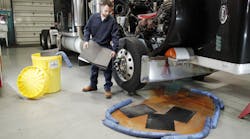When it comes to fleet maintenance, there’s more to the job than meets the eye. Beyond coaching and training technicians, purchasing parts and supplies and controlling inventory, you have the responsibility to ensure the proper use and disposal of hazardous substances used in your shop. Awareness of the regulations and requirements surrounding the use of hazardous substances helps protect your employees and the environment.
Oil, lubricants, solvents and other hazardous substances are regulated by OSHA (Occupational Safety and Health Administration) under the Hazard Communication standard - more commonly called HazCom or the “Right to Know Law,” the Hazardous Waste Operations and Emergency Response standard (HazWoper) and more specific standards such as Flammable and Combustible Liquids, as applicable. The U.S. EPA regulates used oil, hazardous waste and hazardous substances under a variety of regulatory programs.
PROPER PLANNING
If you have hazardous substances in your shop, OSHA requires that you have a written program addressing how the shop complies with the HazCom standard 29 CFR 1910.1200. The program must explain how you meet the requirements for labeling, material safety data sheets (MSDS) and employee training.
Year in and year out, OSHA cites violations of the HazCom Standard more than any other requirement.
The HazCom written plan must include a chemical inventory - a list of all chemicals that are produced, imported or used by your shop - using the identity on the chemical label, whether a chemical name or trade name. It should also include the chemical’s Chemical Abstracts Service (CAS) number.
RECEIPT MANAGEMENT
When chemical orders arrive, check for MSDS and compare them to the containers to make sure everything is properly labeled. The name on the container label and MSDS should match. Do not allow technicians to use any chemicals that don’t have an MSDS at your shop.
OSHA requires every container of hazardous chemicals in your facility to have a label. This label may already appear on the incoming container, or the shop can use an in-house labeling system such as the National Fire Protection Association’s or the Hazardous Material Identification System.
This requirement also applies to portable containers, if the contents are not immediately used by the employee who transferred the chemical.
One other label to be aware of is the U.S. Department of Transportation (DOT) label, if there is one. This label must remain on the container in accordance with the retention provisions of HazCom standard 29 CFR 1910.1201.
APPROPRIATE STORAGE
Improper storage of chemicals, or storing incompatible chemicals together, can cause unwanted reactions, fires or even explosions. Read the MSDS and the container label for information on proper storage.
The Flammable and Combustible Liquids standard 29 CFR 1910.106 generally requires that all flammable or combustible liquids and aerosols be kept in a flammable storage cabinet, inside a storage room or flammable storage warehouse.
There is an exemption for incidental storage, which allows employers to store up to 25 gallons of Class IA and 120 gallons of Class IB, IC, II or III in any one “fire area” of the facility outside of a flammable storage cabinet or storage room. This would apply to substances technicians are using or store around their toolboxes or workbenches.
Your local or state fire code may dictate other storage requirements, and may cover how you store such items as aerosols, so check with your local fire authorities.
Container types - Under OSHA regulations, drums or containers used to store hazardous chemicals must be in good repair and compatible with the chemical placed inside. Containers for flammables and combustibles must be approved, which means that they have been tested by a nationally-recognized laboratory or approved for use in transport by the DOT.
For used oil storage, EPA is clear that storage must be in tanks or other containers subject to regulation under 40 CFR 279. Aboveground tanks and containers must be:
- In good condition (no severe rusting, apparent structural defects or deterioration).
- Free from leaks (no visible leaks).
- Labeled or marked clearly with the words “Used Oil.”
Underground storage tanks for used oil must:
- Have fill pipes labeled or marked clearly with the words “Used Oil.”
- Meet the Underground Storage Tank standard (40 CFR 280) whether or not the used oil exhibits any characteristics of hazardous waste.
Used wipes - Employers must determine if used shop wipes meet the characteristics of hazardous waste since they assume the characteristics of whatever they are used to clean up. If it is determined that the shop wipes are hazardous, requirements for hazardous waste generators with regard to handling and disposal of the waste found at 40 CFR 260 to 280 must be followed.
If wipes are not hazardous, they can be laundered or disposed of in the regular trash, depending on local landfill requirements.
OSHA requires that “combustible waste material and residues in a building or unit operating area shall be kept to a minimum, stored in covered metal receptacles and disposed of daily.” Rags which are soiled with oil, grease and other organic flammable or combustible materials are considered to be combustible waste.
If the wipes are to be laundered, they should be collected daily and gathered at a central point pending pickup by a recycler or launderer. Keep the wipes in an airtight metal container that is regularly emptied, and which is located away from buildings.
SPILL RESPONSE
In a shop environment, technicians need to be ready for spills of any size or substance. Quite often, though, they’ll face small spills that can be safely handled by someone with HazCom training. For example, a small amount of a substance considered low in toxicity and released during a vehicle maintenance operation may be considered an incidental release, not an emergency.
Under OSHA regulations, no formal emergency response training would be necessary if these “incidental spills” meet the following criteria:
- They can be absorbed, neutralized or controlled at the time of the spill by employees in the immediate area or by maintenance personnel.
- They do not pose a significant safety or health hazard to nearby employees or to the employee cleaning up the substance.
- They do not have the potential to become an emergency in a short time.
However, if the shop has the potential for spills that are considered “more than incidental,” and employees are expected to handle them, there’s a good chance that your shop is required to provide extensive emergency response training, special equipment and a written response plan. The training requirements are found in OSHA’s HazWoper regulation 29 CFR 1910.120.
Spills that call for this level of response might include bulk storage tank leaks that seep or spray outside of secondary containment areas. Cargo tanks can also leak hazardous materials and pose emergencies.
EPA, too, requires spill response measures under several regulations that may apply to your maintenance shop. Oil spill response is covered under 40 CFR 112.7, “General Requirements for Spill Prevention, Control and Countermeasure (SPCC) Plans;” 40 CFR 279 Subpart C, “Standards for Used Oil Generators;” and 40 CFR 280 Subpart F, “Release Response and Corrective Action for Underground Storage Tank Systems Containing Petroleum.”
Hazardous waste emergencies are regulated under 40 CFR 262.34 and 265 Subpart D.
In addition, the agency requires immediate notification to appropriate agencies, such as the National Response Center, when a “reportable quantity” of oil or other hazardous substance is released.
WASTE DISPOSAL
There is also the challenge of waste disposal. The use of materials will produce waste, but how this waste will be handled will depend on its characteristics.
If the waste is ignitable, corrosive, reactive, toxic or listed as a hazardous waste in the regulations, then EPA recognizes it as “hazardous waste” and the regulations at 40 CFR 260 to 280 apply.
If the waste is non-hazardous, it may be recycled or disposed of in accordance with local landfill rules.
Used oil - The EPA does not regulate used oil that is being recycled or certain types of used oil filters as hazardous waste, unless the used oil contains a substance that causes it to meet the definition of hazardous waste. Instead, employers are expected to follow standards found at 40 CFR 279 for recycling used oil.
Some states may have more stringent regulations, so checking with your local environmental agency and waste hauler is a best practice.
Aerosol cans - Since many hazardous substances can be packaged in aerosol cans, the method of disposal may be confusing. The EPA is clear that steel aerosol cans that do not contain a “significant amount” of liquid meet the definition of scrap metal and are exempt from hazardous waste regulation if recycled. So, a punctured and drained aerosol would not be considered hazardous waste.
However, this exemption does not apply to any liquid or gas you remove or drain from the aerosol can if that substance meets the definition of hazardous waste.
If an aerosol can is not recycled, but instead tossed into the regular trash, be sure it is “empty” as defined under 40 CFR 261.7 or that the substance inside is non-hazardous.
FINAL WORDS
A commitment to safety can not end with acquiring knowledge. It also takes action. You must plan and prepare your employees and workplace for the proper use and disposal of hazardous substances. This requires putting processes in place for receiving, storing and handling hazardous substances, as well as preparing for spills and waste disposal.
Proper planning, training and actions will ensure that you protect the health and safety of your employees and the environment.



